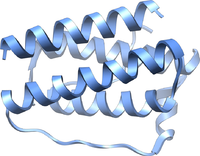
Photo from wikipedia
Aiming to evaluate the effects of increased body energy reserve (BER) in Nellore cows’ reproductive efficiency, cows were fed with different nutritional plans to obtain animals with high BER (HBER;… Click to show full abstract
Aiming to evaluate the effects of increased body energy reserve (BER) in Nellore cows’ reproductive efficiency, cows were fed with different nutritional plans to obtain animals with high BER (HBER; Ad libitum diet) and moderate BER (MBER: cows fed 70% of HBER group ingestion). To evaluate the BER, cows were weekly weighted and evaluated for subcutaneous fat thickness and insulin serum concentration along the experimental period. At the end of the experimental period, animals were submitted to estrous synchronization and artificial insemination. Animals were slaughtered approximately 120 h after ovulation induction and the reproductive tracts were collected for embryo recovery and samples collection. Cumulus-oocyte-complexes (COC) and follicular fluid were collected from 3–6 mm in diameter ovarian follicles to perform miRNA analysis of cumulus cells (CC) and extracellular vesicles from follicular fluid (EV FF). As expected, differences were observed among MBER and HBER groups for body weight, fat thickness, and insulin serum concentration. HBER animals showed lower ovulation and embryo recovery rates compared to MBER animals. Different miRNAs were found among CC and EV FF within groups, suggesting that the BER may influence follicular communication. This suggests that small follicles (3–6 mm diameter) are already under BER effects, which may be greater on later stages of follicular development.
Journal Title: PLOS ONE
Year Published: 2023
Link to full text (if available)
Share on Social Media: Sign Up to like & get
recommendations!